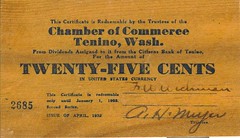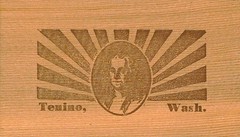
PREV ARTICLE
NEXT ARTICLE
FULL ISSUE
PREV FULL ISSUE
V11 2008 INDEX
E-SYLUM ARCHIVE
QUIZ ANSWER: THE NUMISMATIC SIGNIFICANCE OF TENINO, WASHINGTON
Regarding the numismatic significance of Tenino, Washington, Tom DeLorey coyly writes: Of course I know, but will leave it for others...
Pete Smith writes:
Tenino, Washington was named for its elevation above sea level, ten-nine-oh. Their Chamber of Commerce issued paper scrip in December 1931 and wood flats in 1932. These are considered the first examples of wooden money. More can be found in Depression Scrip of the United States by Mitchell and Shafer.
Del Cushing writes:
Tenino was the first town to produce Legal Tender Wooden Money which was issued as he result of the closing of the bank. Those with money in the bank were allowed to consign up to 15% of their bank account to the Chamber of Commerce in exchange for the wooden money. The first issue was in December, 1931.
The favorite story of the town's name is that comes from the train engine which ran through the town. Its number was 10-9-0. There are other versions of where the name comes from but the train story is what is featured on one of the commemorative wooden money notes.
The favorite story of the town's name is that comes from the train engine which ran through the town. Its number was 10-9-0. There are other versions of where the name comes from but the train story is what is featured on one of the commemorative wooden money notes.
Here's what the City of Tenino has to say on its web site:
In 1872 the railroad from the Columbia reached Hodgden’s farm and a station was built and named “Tenino”. It was the beginning of a settlement that later grew into the Town of Tenino. There is much speculation about the origin of the name, with stories that it was named after a railroad locomotive with number 1090 or a survey stake with that designation marked on it. According to the railroad archives, neither of these tales is true. There is considerable evidence that the name preceded the railroad and is of Indian origin, meaning “a branch in the trail” or “meeting place”.
To read the complete history of Tenino, WA, see: A Brief History of Tenino," By Art Dwelley (www.ci.tenino.wa.us/history_by_dwelley.htm)
The town's web site also has a nice history of the Tenino Wooden Money of 1931. Does anyone own one of the original 25 pieces produced? -Editor
The Nation, and Tenino, was gripped by the Great Depression in 1931, and money was scarce. The Independent in November of that year advocated editorially that scrip be used to meet the currency shortage. Then on December 5, 1931, the matter of emergency struck home with the failure of the Citizens Bank of Tenino. Joel Gould, now of Olympia, came over from Buckley to act as liquidator. This tied-up the accounts of the depositors while the affairs of the defunct bank were being adjusted. Thus the shortage of money became acute. The Tenino Chamber of Commerce met to meet the emergency and agreed to issue scrip to permit the depositors to assign 25% of their bank accounts to the Chamber. The printing press at the Independent office was soon running out of assignment forms and depositors signed for definite amounts of money within the 25% limitations. The printing of $1.00, $5.00 and $10 denomination scrip was done on engraved pieces the size of paper money then in use. The 25 cent denomination was the yellow bond paper without any fancy border. Trustees of the Chamber of Commerce Committee, F.W. Wichman, D.M. Major and A.H. Meyers, signed each piece. They agreed to redeem the certificates “During the Process of Liquidation of the Citizens Bank of Tenino.” This scrip printed in December, 1931 totaled $3,255, of which $1,279 was circulated. Eventually the Chamber redeemed $1,079.75 of this scrip.


Some samples of “slice wood”, a new printing material, had been received from Albert Balch of Seattle, who was promoting it for Christmas cards and other items. This was made in a special machine at Aberdeen by a man named Eckersley. Sitka Spruce and Port Orford and red cedar were used. The first pieces were flimsy sheets of 1/80th of an inch thick. The 25 on hand were sufficient to put Tenino in the wooden money business. Later the slices were sandwiched with a paper in between. One issue of a thousand even carried a “watermark” reading “Confidence makes good; Money made of wood”, which could be seen by holding it up to the light. This was supposed to guard against counterfeiting.
The publicity of Tenino Wooden Money began to snowball in February, 1932, the old Seattle Star carrying the story early that month, followed by the Tacoma News-Tribune, Oregonian, Seattle P-I and others. The Halls of Congress heard of the unique method of meeting the money shortage and in March it was featured in the Congressional Record. Thousands of stories and comments appeared over the world in newspapers and magazines. Orders from collectors and souvenir hunters came in increasing demand and eight issues were printed through 1933, mostly in 25 cent denominations, but also in 50 cent and $1.00. In all $10,308 worth of wooden money was issued of which about $40 was redeemed by the Chamber of Commerce. In April, 1935, business people used small wooden fifth cent tax tokens due to a state shortage of tokens. Like the original wooden money, they are now quite valuable.
To read the complete article, see: The Complete Story of Tenino Wooden Money By Don Major, from the Thurston County Independent, Feb. 19, 1965 (www.ci.tenino.wa.us/wooden_money.htm)
Wayne Homren, Editor
The Numismatic Bibliomania Society is a non-profit organization promoting numismatic literature. See our web site at coinbooks.org.
To submit items for publication in The E-Sylum, write to the Editor at this address: whomren@gmail.com
To subscribe go to: https://my.binhost.com/lists/listinfo/esylum
All Rights Reserved.
NBS Home Page
Contact the NBS webmaster
